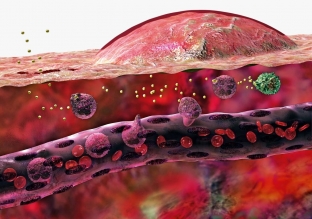Every year in aesthetic medicine, new methods of influencing the skin appear, which often turn out to be traumatic, violate the integrity of its epidermal barrier. To minimize the negative consequences of such damage allows proper care after the procedure, and this should not be forgotten by the practicing cosmetologist. The mechanisms of skin restoration after a cosmetic procedure are rather complicated, let's try to figure them out with estet-portal.com.
The first stage of skin healing after the – fibrin clot formation
If the procedure was accompanied by damage to the blood vessels of the dermis, then the body in response, it forms a clot consisting of platelets, fibrin filaments, glycoproteins of the extracellular matrix. Its function is to protect damaged tissues from possible infection. In addition, cytokines and growth factors are concentrated in the fibrin clot – epidermal, transforming, platelet, insulin-like, vasculoendothelial, fibroblast and connective tissue growth factors. These elements cause the cells of the immune system to move to the site of damage, stimulate angiogenesis, and start tissue repair processes.
The connective tissue of a fibrin clot appears outwardly covered with small red grains (granules). The fact is that capillaries grow here from the surrounding tissues, which, reaching the wound surface, bend like a loop and grow back deep into the tissue. This explains the name of the young connective tissue – granular (granulation).
The second stage of skin healing – inflammation and proliferation
Immune system cells rush to the site of skin damage caused by a cosmetic procedure – monocytes and neutrophils, normally after a few minutes we can observe the first signs of an inflammatory reaction at the site of damage. The role of immune cells, according to recent studies, is not only to neutralize bacteria penetrating the wound surface, but also to produce pro-inflammatory cytokines that activate the production of fibroblasts and keratinocytes.
In intact skin, keratinocytes normally attach to the basement membrane using special receptors – integrins. When the skin is damaged, the old bonds break down and the keratinocytes form a new kind of receptor that allows them to migrate.
A few hours after skin damage, the so-called proliferative explosion occurs – when keratinocytes begin to divide very actively and move towards the wound surface in order to replenish the destroyed epidermal barrier.

The third stage of skin healing – re-epithelialization and scarring
In addition to keratinocytes, during the healing period of the wound surface, dermal fibroblasts also actively divide, which also move towards the fibrin clot and synthesize collagen fibers. In order to penetrate to the surface of the wound, actively dividing cells must overcome the fibrin clot. Migrating keratinocytes are capable of synthesizing – plasmin, metalloproteinases – each of which is able to dissolve a certain type of matrix proteins and destroy the fibrin clot. After the lower surface of the wound is filled with keratinocytes, migration stops, and a new full-fledged epidermis is formed.
If the skin has been damaged very deeply, then the collagen fibers produced by fibroblasts can displace the rest of the tissue. In such areas of the skin, there are few other cells, the vessels almost do not penetrate – and scar tissue.
Understanding the processes of skin repair helps to plan cosmetic interventions so that healing takes place as quickly as possible and without side effects, allowing patients to quickly return to everyday life and see the successful results of the procedures performed.







Add a comment